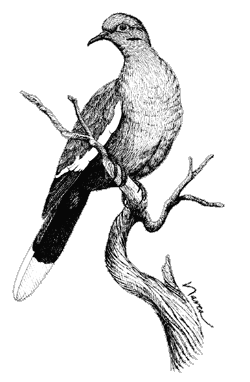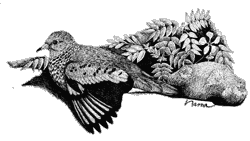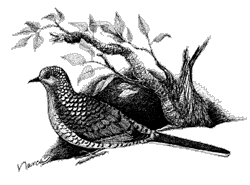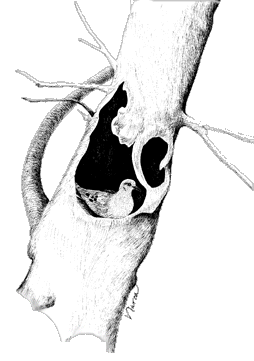Doves
 |
The Sonoran Desert would have a very different sound if it were not for the doves. The cooing songs of four species are among the classic bird voices here for much of the year.
Mourning Doves are found throughout North America except for the coldest regions, but in the desert they are among the most numerous birds year-round. A bigger relative, the White-winged Dove, is extremely common along southwestern rivers in summer. The rich cooing of the white-wings on spring mornings may virtually drown out the voices of other birds. More unobtrusive is the little Common Ground-Dove, which usually stays close to dense thickets. Another small species, the Inca Dove, is not really a desert bird; it is more likely to be found mincing about on lawns. Spreading north out of Mexico, it has become one of the most familiar birds in southwestern U.S. cities.
About 300 species of doves and pigeons are found worldwide. All have short blunt bills, stout bodies, and rather small heads. Our doves eat mostly seeds, but tropical species may eat many small fruits as well. Dove nests are haphazard platforms of sticks, so flimsy that the eggs or young sometimes fall through them; as if to make up for this, the birds may make repeated nesting attempts, raising several broods per year.
Doves love water, and it is only through their strong powers of flight that they are able to thrive in the desert; they may fly long distances to get to reliable sources of water. Flocks of doves hurtling overhead are a characteristic sight on desert evenings.
—Kenn KaufmanDoves
Sonoran Desert species:
White-winged Dove (Zenaida asiatica)
Mourning Dove (Zenaida macroura)
Common Ground-Dove (Columbina passerina)
Inca Dove (Columbina inca)
Order: Columbiformes
Family: Columbidae
Spanish Names: paloma pitahayera and paloma de alas blancas (White-winged
Dove), huilota común, paloma triste and tórtola coluda (Mourning Dove),
tortolita común (Inca Dove), tortolita de milpas (Ground-dove)
Distinguishing Features
The White-winged Dove is a light brown bird with a white patch on the wing (it looks like a thin, white border when the wings are folded). Tail is round and outer feathers are tipped in white.The Mourning Dove has a brown body, blue-gray wings, and long pointed tail. The Inca Dove is pale brown; rufous primaries are visible when the bird displays or flies; upper body looks scaled; slender tail with white sides.The Common Ground-Dove is light brown with a short black tail; it looks slightly scaled. The adult male has a blue crown with much purple in the neckshield area and shoulders. This is the smallest dove in the area.
 |
Habitat
The White-winged Dove is found in all desert habitats; most leave for the winter although pockets remain, especially in suburbs and in riparian zones. The Mourning Dove is found in all desert habitats throughout the year. The Inca Dove is most often found around human settlements throughout much of the Sonoran Desert region. The Common Ground-Dove is found throughout the year most often in dense brushy desert or in riparian areas.
Feeding
 |
• Diet: All 4 doves are seed and fruit eaters. Doves grind seeds in their muscular stomachs (or gizzards) using sand or gravel much like internal teeth.
Life History
Doves are strong, fast fliers and noisy too, as they clap their wings together when they start into flight. Doves can live in deserts because they can fly long distances to find food and water. During winter they congregate, but pair off during breeding season. Dove nests look like flimsy, careless arrangements, and they can be built almost anywhere—in trees, on the ground, in hanging pots. A pair can raise several broods a year.
 |
The Inca Dove has the longest breeding season of any Arizona bird: January to November. That fact, plus its preference for grass and weed seeds, have made the Inca Dove the most abundant bird in southwestern urban areas, after the house sparrow.
White-winged Doves are important players in the life history of the saguaro. Along with bats, bees, and other insects, they help pollinate it as they fly from flower to flower to sip nectar. White-winged Doves also disperse saguaro seeds: they eat the fruit, then regurgitate it to their young; in the process some seed falls beneath the nest where it germinates, and the young saguaro grows in the protection of the tree.










